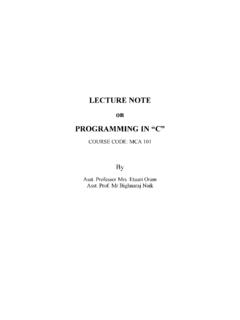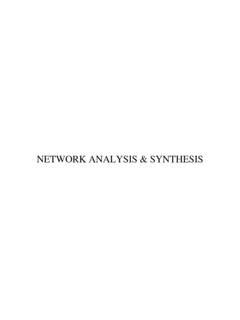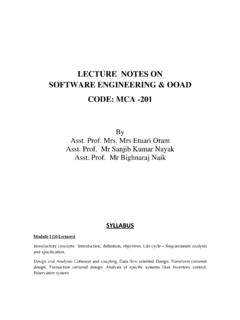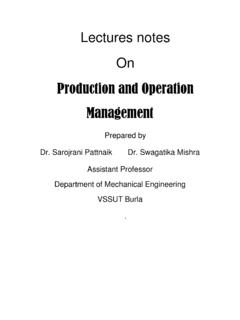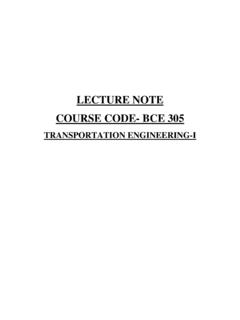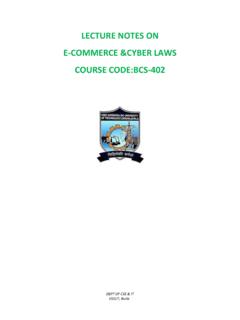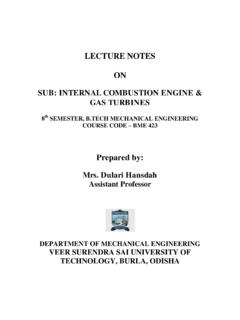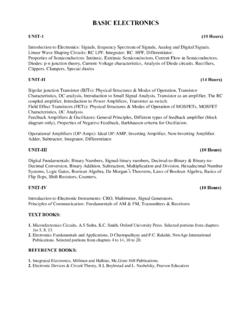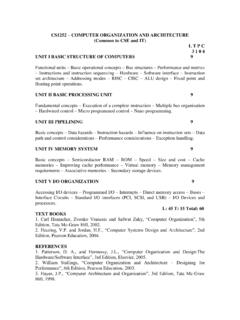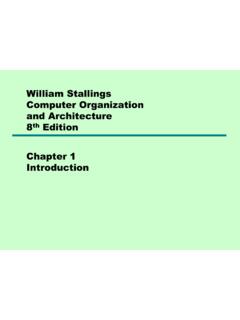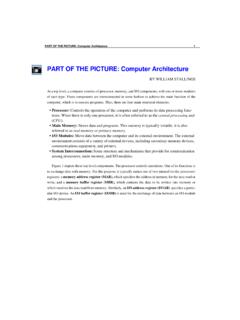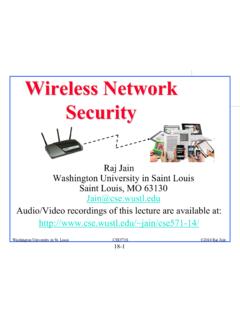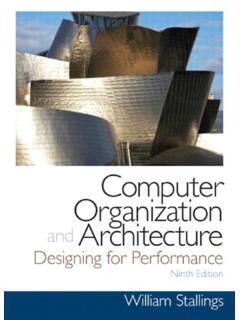Transcription of COMPUTER ORGANIZATION (3-1-0 )
1 VEER SURENDRA SAI UNIVERSITY OF TECHNOLOGY, BURLA, ODISHA Lecture notes of BCS-203 COMPUTER ORGANIZATION (3-1-0 ) Text Books: 1. COMPUTER ORGANIZATION , Hamacher, TMH 2. COMPUTER System architecture , Morris Mano, PHI Reference Books: 1. COMPUTER architecture & ORGANIZATION , william stallings , Pearson Prerequisite 1. Knowledge of digital circuit 2. Functionality of various gates 3. Number System Generated by Foxit PDF Creator Foxit For evaluation only. VEER SURENDRA SAI UNIVERSITY OF TECHNOLOGY, BURLA, ODISHA Syllabus: 4TH SEMESTER (CSE, IT) BCS-203 COMPUTER ORGANIZATION 1 (3-1-0 ) Introduction: (05 Period) Basic ORGANIZATION of Computers, Classification Micro, Mini, Mainframe and Super COMPUTER . System Bus and Interconnection, PCI, COMPUTER Function, I-Cycle, Interrupt and Class of Interrupts, Von-Neumann M/c: Structure of IAS.
2 CPU ORGANIZATION : (05 Period) Fundamental Concepts: Fetching and storing a word in Memory, Register Transfer, Performing an Arithmetic & Logic Operation, Execution of a Completes, Branching. General Register ORGANIZATION : (15 Period) Control word, Examples of Microsoft, Stack Organisation, Register Stack, Memory Stack, RPN, Ecaluation of Arithmetic Expression using RPN, Instruction Format: Three Address, Two Address, One Address and Zero Address Instruction, Addressing Modes: Types of Addressing modes, Numerical Examples, Program Relocation, Compaction, Data Transfer & Manipulation: Data transfer, Data Manipulation, Arithmetic, Logical & Bit Manipulation Instruction, Program Control: Conditional Branch Instruction, Subroutine, Program Interrupt, Types of Interrupt, RISC & CISC Characteristic.
3 Control Unit Operation: Hardware Control & Micro Programmed Control. Input/Output ORGANIZATION : (10 Period) Peripheral Devices, Input output Interface, I/O Bus, Interface Module, Asynchronous Data Transfer, Strobe Control, Handshaking, Asynchronous Serial Transfer, Asynchronous Communication Interface, Modes of Transfer: Programmed I/O, Interrupt Driven I/O, Direct Memory Access (DMA), DMA Controller, I/O Channel & Processor. Priority Interrupt: Daisy Chaining Priority, Parallel Priority Interrupt. Memory ORGANIZATION : (15 Period) Computers Memory System Overview, Characteristics of Memory System, The Memory Hierarchy, Semi Conductor Main Memory types, Organisation, Memory cell Operation. Generated by Foxit PDF Creator Foxit For evaluation only. VEER SURENDRA SAI UNIVERSITY OF TECHNOLOGY, BURLA, ODISHA Cache Memory: Cache Principles, Elements of Cache Design, Cache Size, Mapping function, Replacement Algorithm, LRU, FIFO, LFU, Write policy.
4 Number of Caches: Single versus two level caches, Pentium Cache Organisation. Associative Memory: Hardware Organisation, Match Logic. Read Operation, Write Operation, Auxiliary Memory: Magnetic Disks, Magnetic Tape. Virtual Memory: Paging, Paging h/w, Address Mapping using pages, Segmentation h/w, Demand Paging, Memory Management h/w. Text Books: 1. COMPUTER ORGANIZATION & architecture william stallings , 4th Edition, PHI 2. COMPUTER System architecture : Morris Mano, 3rd Edition, PHI Reference Books: 1. COMPUTER ORGANIZATION by Hamacher, , and , 3rd Edition. McGraw Hill, 2. COMPUTER architecture and ORGANIZATION , by - John P. Hayes, 3rd Edition, Mc Graw Hill International Editions. 3. COMPUTER ORGANIZATION & Design, (3rd Edition) by & Morgan Kaufmann Publishers (Elseviers) Generated by Foxit PDF Creator Foxit For evaluation only.
5 VEER SURENDRA SAI UNIVERSITY OF TECHNOLOGY, BURLA, ODISHA Module-I Introduction: What is a COMPUTER ? A machine for high end computation. An extended size of a calculator. It can be analog, if it processes data in form of analog devices and digital, if processes data in form of digital signal. Why to use COMPUTER ? Applications of a COMPUTER : COMPUTER is used in business organisations for: Payroll calculations Budgeting Sales analysis Financial forecasting Managing employees database Maintenance of stocks etc. Today banking is almost totally dependent on COMPUTER . Banks provide online accounting facility, which includes current balances, deposits, overdrafts, interest charges, shares, and trustee records. ATM machines are making it even easier for customers to deal with banks. The COMPUTER has provided a lot of facilities in the education system.
6 The COMPUTER provides a tool in the education system known as CBE ( COMPUTER Based Education). CBE involves control, delivery, and evaluation of learning. The COMPUTER education is rapidly increasing the graph of number of COMPUTER students. Generated by Foxit PDF Creator Foxit For evaluation only. VEER SURENDRA SAI UNIVERSITY OF TECHNOLOGY, BURLA, ODISHA There are number of methods in which educational institutions can use COMPUTER to educate the students. It is used to prepare a database about performance of a student and analysis is carried out on this basis. In marketing, uses of COMPUTER are following: Advertising - With computers, advertising professionals create art and graphics, write and revise copy, and print and disseminate ads with the goal of selling more products. At Home Shopping - Home shopping has been made possible through use of computerised catalogues that provide access to product information and permit direct entry of orders to be filled by the customers.
7 Computers are widely used in Engineering purpose. One of major areas is CAD ( COMPUTER aided design). That provides creation and modification of images. Some fields are: Structural Engineering - Requires stress and strain analysis for design of Ships, Buildings, Budgets, Airplanes etc. Industrial Engineering - Computers deal with design, implementation and improvement of integrated systems of people, materials and equipments. Architectural Engineering - Computers help in planning towns, designing buildings, determining a range of buildings on a site using both 2D and 3D drawings. Computers are largely used in defense: Modern tanks, missiles, weapons etc. Military also employs computerised control systems. Some military areas where a COMPUTER has been used are: Missile Control Military Communication Generated by Foxit PDF Creator Foxit For evaluation only.
8 VEER SURENDRA SAI UNIVERSITY OF TECHNOLOGY, BURLA, ODISHA Military Operation and Planning Smart Weapons Communication: means to convey a message, an idea, a picture or speech that is received and understood clearly and correctly by the person for whom it is meant for. Some main areas in this category are: E-mail Chatting Usenet FTP Telnet Video-conferencing Computers play an important role in government: Budgets Sales tax department Income tax department Male/Female ratio Computerization of voters lists Computerization of driving licensing system Computerization of PAN card Units of a COMPUTER system: To provide the information to be computed and interacting purpose ( Input Unit: Like Monitor, Mouse, Joystick etc.) To compute and control the whole system (CPU : CO +ALU) To get & sense the result ( Output Unit: Like Monitor, Printer, Micro phones, speakers etc) Generated by Foxit PDF Creator Foxit For evaluation only.
9 VEER SURENDRA SAI UNIVERSITY OF TECHNOLOGY, BURLA, ODISHA To store the information for future referencing ( Memory: Like Hard disc, flash memory, magnetic tape, ROM, RAM etc.) Block diagram of a COMPUTER Fig:1: Block Diagram of a COMPUTER Structure Simplest possible view of a COMPUTER show in figure 1: o Storage o Processing o Peripherals o Communication Lines Brief History of Computers 1. First Generation: Vacuum Tubes 1943-1946: ENIAC Generated by Foxit PDF Creator Foxit For evaluation only. VEER SURENDRA SAI UNIVERSITY OF TECHNOLOGY, BURLA, ODISHA first general purpose COMPUTER designed by Mauchly and Eckert. The ENIAC was a decimal rather than a binary machine. That is, numbers were represented in decimal form, and arithmetic was performed in the decimal system. Its memory consisted of 20 accumulators each capable of holding a 10-digit decimal number.
10 A ring of 10 vacuum tubes represented each digit. At any time, only one vacuum tube was in the ON state, representing one of the 10 digits. The major drawback of the ENIAC was that it had tube programmed manually by setting switches and plugging and unplugging cables. The first task was to perform series of complex calculation that is helped determine Hydrogen-bomb feasibility instead. General purpose use only. It can process 30 tons + 15000 sq. ft. + 18000 vacuum tubes + 140 KW = 5000 additions/sec Vvon Neumann Machine 1945: stored-program concept first implement for EDVAC. Key concepts: Data to be processed and instructions to b executed on those data are stored in a single read-write memory The contents of this memory are addressable by location, without regard to the type of data contained there. Execution occurs in a sequential fashion (unless explicitly modified) from one instruction to the next.
